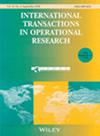值得吗?利用 DEA 分析大学院系合并的效率收益和成本:马德里康普斯顿大学案例研究
IF 3.1
4区 管理学
Q2 MANAGEMENT
引用次数: 0
摘要
本文旨在分析马德里康普顿斯大学(UCM)2017 年进行的大学院系合并的益处。合并后,原来的 184 个系减少到 97 个,形成了新的结构。为此,我们使用数据包络分析法(DEA)来评估合并过程的效率收益,将效率分解为三种节约效应:学习效应、和谐效应和规模效应。他们将效率分解为三种节约效应:学习效应、和谐效应和规模效应。此外,我们还引入了一种新的监管效应,它考虑了 DEA 分析中未包括的其他潜在递归节约效应。我们的研究结果表明,UCM 在合并过程中节省了约 2050 万欧元,其中约 660 万欧元来自监管效应。随着时间的推移,这些节余将逐年复制和积累。结果还显示,由于谈判激烈,2017 年参与合并进程的院系的学术人员可能比未合并院系的学术人员请了更多天病假,尽管在标准水平上这一增长并不显著。本文章由计算机程序翻译,如有差异,请以英文原文为准。
Is it worth it? Using DEA to analyze the efficiency gains and costs of merging university departments: a case study of the Complutense University of Madrid
The aim of this paper is to analyze the benefits of the university department merger undertaken by the Complutense University of Madrid (UCM) in 2017. The merger led to a new structure in which the original 184 departments were reduced to 97. To do this, we use the data envelopment analysis (DEA) to evaluate the efficiency gains of a merger process decomposing efficiency into three savings effects: learning, harmony, and scale effects. They decomposed efficiency into three savings effects: learning, harmony, and scale effects. Additionally, we introduce a new regulatory effect, which accounts for other potential recursive savings not included in the DEA analysis. Our results suggest that the merger process undertaken by the UCM achieved savings of around 20.5 million euros, approximately 6.6 million euros, which is accounted for by the regulatory effect. These savings will reproduce and accumulate annually over time. The results also show that, as a result of the intense negotiations, academic staff based at faculties engaged in the merger process may have taken more days of sick leave than academics from unmerged faculties in 2017, although the increase is not significant at standard levels.
求助全文
通过发布文献求助,成功后即可免费获取论文全文。
去求助
来源期刊

International Transactions in Operational Research
OPERATIONS RESEARCH & MANAGEMENT SCIENCE-
CiteScore
7.80
自引率
12.90%
发文量
146
审稿时长
>12 weeks
期刊介绍:
International Transactions in Operational Research (ITOR) aims to advance the understanding and practice of Operational Research (OR) and Management Science internationally. Its scope includes:
International problems, such as those of fisheries management, environmental issues, and global competitiveness
International work done by major OR figures
Studies of worldwide interest from nations with emerging OR communities
National or regional OR work which has the potential for application in other nations
Technical developments of international interest
Specific organizational examples that can be applied in other countries
National and international presentations of transnational interest
Broadly relevant professional issues, such as those of ethics and practice
Applications relevant to global industries, such as operations management, manufacturing, and logistics.
 求助内容:
求助内容: 应助结果提醒方式:
应助结果提醒方式:


